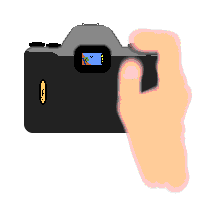
Many of you wannabe photographers out there don't want to take boring classes or buy books to learn tricks of the trade. That's why, for all of those people, I took the great pain of making this page. Yeah, you can thank me later.
First of all, anybody who needs to take better photos should visit the Pentax homepage. When you get there, you can find out about their products (I would personally recomend the ZX-50 for begginers) or click on the Pentax University link and learn how to take better pictures.
Just so that you all braindead people know, the prices on the Pentax page are manufacturer recommended. For instance, the ZX-50 is said to be about $330 (body only), while I got mine with a really nice lens all for $300, paying only $200 for the body.
Shutter speed and aperature are the most usefull peices of information that a camera (except point-and-shoots and digital cameras) needs to know in order to make a correct exposure (photo).
Shutter speed is easy to understand.........The higher the speed, the less time light strikes the film, the less light your photo is. Shutter speed can also stop fast action. In this case, use a higher shutter speed to stop action, or a slower one to see it flow. Most cameras can set this speed and aperature automatically for begginers, but some can't. I'm not going to go into these subjects that much, because this website refers to beginning photographers.
Aperature controls the depth of feild. In other words, for example, if you set your aperature to 5.6 (open), you would only be getting about a foot or two before and behind the focused subject in clear focus. Everything else would be out of focus. This works great when you want a person to stand out of the picture. Yet, if you use a 22 or 32 (closed down) aperature, then you can get even several hundred feet in front and behind the subject. This is really cool for scenic shots. Aperature can also have a little bit of an effect on how much light strikes the film. For instance, if you are in a dark area, you should use an open aperature like 5.6 or 3.5, a lower shutter speed (prefferably 1/60 of a second...A too-low speed could mean a bad case of camera shake, which is the natural movements of your hands. At a very low speed, these tiny movements can cause a blury picture) and, you probably will have to use a flash.
More TipsThis page is always subject to updates.
Did I forget a site? Want your site here? Or, would you like to add a tip to this page? Email me, Alex